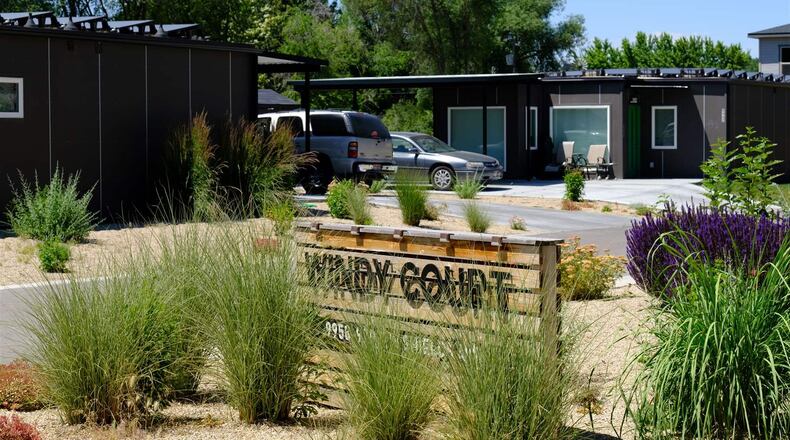Riley Romazko and her fiancé Julien Rivera were among the first to buy a shipping container home at Caritas Commons, a cluster of single-family houses built for limited-income residents on a quiet street in an older Boise, Idaho neighborhood.
Romazko, 27, who runs an online naturopath consultancy and Rivera, 29, who owns a small moving company, had been living for three years with Romazko’s mother and her boyfriend in nearby Nampa, and they were eager to find their own place.
But as the median sales price in Ada County reached $595,000 earlier this year, Romazko said owning their own home looked increasingly out of reach.
Credit: contributed
Credit: contributed
Romazko’s mother was working at indieDwell, a company that specializes in recycling shipping containers into dwellings. Romazko was intrigued by the prospect of living in one, especially if it was affordable.
That’s when she discovered LEAP, a Boise nonprofit that builds affordable homes, often using donated land held in trust. Caritas Commons was one of LEAP’s first communities built with such a housing trust, which keeps the home prices lower for not just the first buyers, but subsequent owners, said Zeb Moers, the nonprofit’s outreach manager.
Across the street are the Windy Court apartments, also developed by LEAP, distinctive for their drought-friendly plantings and the industrial black shipping containers used to build the rentals.
Both developments represent some of the modest but innovative approaches to affordable housing in a state that’s seen home prices boom with its population.
The use of alternative construction techniques and materials, along with creative means of land ownership and financing and siting homes may help more people live in one of the fastest-growing metro areas in the nation.
High rents and a limited inventory of available homes plague many states, driving up prices and contributing to homelessness. Nationwide, there’s an estimated shortage of 3.8 million housing units. Finding a way to make homes more affordable and accessible is the No. 1 priority in many jurisdictions, including Boise.
Efforts throughout the country include updating zoning regulations to allow for denser development, and even spurring the construction of manufactured homes.
More cities and states also are permitting accessory dwelling units, or ADUs – smaller secondary cottages or in-law apartments on a lot or within a single-family home.
Since the start of the pandemic, Idaho has seen an influx of people fleeing more expensive markets in search of relative bargains, as well as remote workers eager for a mountain lifestyle, who arrive with Silicon Valley salaries to spend on housing. Rents also have become particularly unaffordable in the Boise area.
LEAP is phasing out the use of shipping containers, and future homes at Caritas will be built using more traditional construction techniques. But the materials are only a part of what makes their approach affordable, Moers said.
The apartments they built at Windy Court, for example, have solar panels on the roof to keep utility costs low for residents – the motto for the apartment complex is that it’s “designed like the planet matters.” Older adults and people with disabilities get priority placement.
In Spokane, a city in eastern Washington that also has seen housing sticker shock, the city council is considering a one-year pilot program to allow denser development, including permitting duplexes in most parts of the city.
Spokane’s move mirrors innovations long underway in Portland and other Oregon cities, where a 2019 state law ended the single-family zoning regulations that have defined many American cities and suburbs since World War II.
In areas once zoned exclusively for single-family homes, smaller Oregon cities must allow duplexes, and cities larger than 25,000 people must allow duplexes as well as townhouses, triplexes and fourplexes. Portland also allows sixplexes on lots once zoned for a single home.
Oregon has begun seeking even more ways to expand access to housing, including a renewed emphasis on manufactured housing, said State Rep. Pam Marsh, a Democrat who represents a southern Oregon district where wildfires destroyed 1,500 mobile homes in 2020.
Marsh sponsored successful legislation that expands where factory-built homes can be sited in Oregon, as well as what they can look like. (Some of the regulations dated to the 1980s, when the industry itself asked for more stringent guidelines, including minimum square footages on mobile homes, to help reduce the former stigma of living in them.)
Marsh also funneled $15 million in state housing money toward the construction of a new, nonprofit manufactured home factory run by the St. Vincent de Paul charity. That facility could be operational next year in a former steel plant in Eugene. One of its chief goals would be to manufacture homes for people who lost theirs to wildfire.
In Boise, LEAP is administering a pilot program to see whether it makes sense to incorporate more types of housing into the city’s portfolio, including tiny homes on wheels and ADUs.
Currently, tiny homes aren’t allowed in Boise. But 55 people applied for six spots in the pilot program, Moers said, proving there’s a demand.
No single approach will solve the housing crisis, and Boise is certainly not the first to integrate ADUs, tiny homes or sweeping zoning changes into its approach to finding people homes.
But if the ADUs and tiny homes work in Boise, said Kyle Patterson, a city official in the mayor’s office, it might prove to be among the scalable solutions that could make alternative forms of housing more affordable and available without contributing to sprawl.
Erika Bolstad writes for Stateline, an initiative of The Pew Charitable Trusts.
About the Solutions Journalism Network
This story is republished through our partners at the Solutions Journalism Network, a nonprofit organization dedicated to rigorous reporting about social issues.
About the Author
Keep Reading
The Latest
Featured



